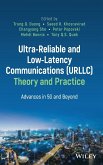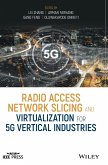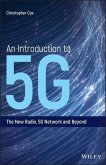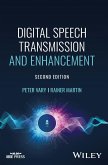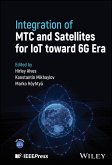Haijian Sun (USA Utah State University), Rose Qingyang Hu (National Inst. of Standards & Technology), Yi Qian (USA University of Nebraska-Lincoln)
5g and Beyond Wireless Communication Networks
131,99 €
inkl. MwSt.
Versandkostenfrei*
Liefertermin unbestimmt
Melden Sie sich
hier
hier
für den Produktalarm an, um über die Verfügbarkeit des Produkts informiert zu werden.
oder sofort lesen als eBook

66 °P sammeln
Haijian Sun (USA Utah State University), Rose Qingyang Hu (National Inst. of Standards & Technology), Yi Qian (USA University of Nebraska-Lincoln)
5g and Beyond Wireless Communication Networks
- Gebundenes Buch
This book looks at the recent progress of research and development for 5G mobile wireless networks, covering related topics on fundamental 5G requirements and enabling technologies.
Andere Kunden interessierten sich auch für
![Ultra-Reliable and Low-Latency Communications (Urllc) Theory and Practice Ultra-Reliable and Low-Latency Communications (Urllc) Theory and Practice]() Ultra-Reliable and Low-Latency Communications (Urllc) Theory and Practice128,99 €
Ultra-Reliable and Low-Latency Communications (Urllc) Theory and Practice128,99 €![5g Technology 5g Technology]() 5g Technology109,99 €
5g Technology109,99 €![Radio Access Network Slicing and Virtualization for 5G Vertical Industries Radio Access Network Slicing and Virtualization for 5G Vertical Industries]() Radio Access Network Slicing and Virtualization for 5G Vertical Industries142,99 €
Radio Access Network Slicing and Virtualization for 5G Vertical Industries142,99 €![An Introduction to 5G An Introduction to 5G]() Christopher Cox (Chris Cox Communications Ltd)An Introduction to 5G113,99 €
Christopher Cox (Chris Cox Communications Ltd)An Introduction to 5G113,99 €![Digital Speech Transmission and Enhancement Digital Speech Transmission and Enhancement]() Peter Vary (Germany RWTH Aachen University)Digital Speech Transmission and Enhancement133,99 €
Peter Vary (Germany RWTH Aachen University)Digital Speech Transmission and Enhancement133,99 €![Engineering and Technology for Healthcare Engineering and Technology for Healthcare]() Muhammad Ali ImranEngineering and Technology for Healthcare138,99 €
Muhammad Ali ImranEngineering and Technology for Healthcare138,99 €![Integration of Mtc and Satellites for Iot Toward 6g Era Integration of Mtc and Satellites for Iot Toward 6g Era]() Integration of Mtc and Satellites for Iot Toward 6g Era149,99 €
Integration of Mtc and Satellites for Iot Toward 6g Era149,99 €-
-
-
This book looks at the recent progress of research and development for 5G mobile wireless networks, covering related topics on fundamental 5G requirements and enabling technologies.
Hinweis: Dieser Artikel kann nur an eine deutsche Lieferadresse ausgeliefert werden.
Hinweis: Dieser Artikel kann nur an eine deutsche Lieferadresse ausgeliefert werden.
Produktdetails
- Produktdetails
- IEEE Press
- Verlag: Wiley / Wiley & Sons
- Artikelnr. des Verlages: 1W119089450
- 1. Auflage
- Seitenzahl: 208
- Erscheinungstermin: 12. September 2023
- Englisch
- Abmessung: 250mm x 175mm x 16mm
- Gewicht: 510g
- ISBN-13: 9781119089452
- ISBN-10: 111908945X
- Artikelnr.: 60008431
- Herstellerkennzeichnung
- Libri GmbH
- Europaallee 1
- 36244 Bad Hersfeld
- gpsr@libri.de
- IEEE Press
- Verlag: Wiley / Wiley & Sons
- Artikelnr. des Verlages: 1W119089450
- 1. Auflage
- Seitenzahl: 208
- Erscheinungstermin: 12. September 2023
- Englisch
- Abmessung: 250mm x 175mm x 16mm
- Gewicht: 510g
- ISBN-13: 9781119089452
- ISBN-10: 111908945X
- Artikelnr.: 60008431
- Herstellerkennzeichnung
- Libri GmbH
- Europaallee 1
- 36244 Bad Hersfeld
- gpsr@libri.de
Haijian Sun, PhD, is an Assistant Professor in the School of Electrical and Computer Engineering at the University of Georgia in Athens, USA. His research interests include wireless communications for 5G and beyond, efficient edge computing, wireless security, and wireless for distributed learning. Rose Qingyang Hu, PhD, is a Professor in the Department of Electrical and Computer Engineering at Utah State University in Logan, USA. Her research interests include next-generation wireless communications, wireless network design and optimization, and more. Yi Qian, PhD, is a Professor in the Department of Electrical and Computer Engineering at the University of Nebraska-Lincoln in Omaha, USA. His research interests include cyber security and communication network security, computer networks, and wireless networks.
About the Authors xi
Preface xiii
Acknowledgments xv
1 Introduction to 5G and Beyond Network 1
1.1 5G and Beyond System Requirements 1
1.1.1 Technical Challenges 2
1.2 Enabling Technologies 3
1.2.1 5G New Radio 3
1.2.1.1 Non-orthogonal Multiple Access (NOMA) 3
1.2.1.2 Channel Codes 5
1.2.1.3 Massive MIMO 5
1.2.1.4 Other 5G NR Techniques 6
1.2.2 Mobile Edge Computing (MEC) 6
1.2.3 Hybrid and Heterogeneous Communication Architecture for Pervasive IoTs 7
1.3 Book Outline 8
2 5G Wireless Networks with Underlaid D2D Communications 11
2.1 Background 11
2.1.1 MU-MIMO 11
2.1.2 D2D Communication 11
2.1.3 MU-MIMO and D2D in 5G 12
2.2 NOMA-Aided Network with Underlaid D2D 12
2.3 NOMA with SIC and Problem Formation 14
2.3.1 NOMA with SIC 14
2.3.2 Problem Formation 15
2.4 Precoding and User Grouping Algorithm 15
2.4.1 Zero-Forcing Beamforming 16
2.4.1.1 First ZF Precoding 16
2.4.1.2 Second ZF Precoding 16
2.4.2 User Grouping and Optimal Power Allocation 16
2.4.2.1 First ZF Precoding 17
2.4.2.2 Second ZF Precoding 18
2.5 Numerical Results 18
2.6 Summary 19
3 5G NOMA-Enabled Wireless Networks 21
3.1 Background 21
3.2 Error Propagation in NOMA 22
3.3 SIC and Problem Formulation 22
3.3.1 SIC with Error Propagation 23
3.3.2 Problem Formation 24
3.4 Precoding and Power Allocation 25
3.4.1 Precoding Design 25
3.4.2 Case Studies for Power Allocation 26
3.4.2.1 Case I 26
3.4.2.2 Case II 27
3.5 Numerical Results 27
3.6 Summary 30
4 NOMA in Relay and IoT for 5G Wireless Networks 31
4.1 Outage Probability Study in a NOMA Relay System 31
4.1.1 Background 31
4.1.2 System Model 32
4.1.2.1 NOMA Cooperative Scheme 32
4.1.2.2 NOMA TDMA Scheme 34
4.1.3 Outage Probability Analysis 35
4.1.3.1 Outage Probability in NOMA Cooperative Scheme 35
4.1.4 Outage Probability in NOMA TDMA Scheme 36
4.1.5 Outage Probability with Error Propagation in SIC 37
4.1.5.1 Outage Probability in NOMA Cooperative Scheme with EP 38
4.1.5.2 Outage Probability in NOMA TDMA Scheme with EP 38
4.1.6 Numerical Results 39
4.2 NOMA in a mmWave-Based IoT Wireless System with SWIPT 41
4.2.1 Introduction 41
4.2.2 System Model 41
4.2.2.1 Phase 1 Transmission 42
4.2.2.2 Phase 2 Transmission 44
4.2.3 Outage Analysis 45
4.2.3.1 UE 1 Outage Probability 45
4.2.3.2 UE 2 Outage Probability 45
4.2.3.3 Outage at High SNR 47
4.2.3.4 Diversity Analysis for UE 2 47
4.2.4 Numerical Results 47
4.2.5 Summary 48
5 Robust Beamforming in NOMA Cognitive Radio Networks: Bounded CSI 51
5.1 Background 51
5.1.1 RelatedWork and Motivation 52
5.1.1.1 Linear EH Model 52
5.1.1.2 Non-linear EH Model 53
5.1.2 Contributions 53
5.2 System and Energy Harvesting Models 54
5.2.1 System Model 54
5.2.2 Non-linear EH Model 55
5.2.3 Bounded CSI Error Model 55
5.2.3.1 NOMA Transmission 56
5.3 Power Minimization-Based Problem Formulation 56
5.3.1 Problem Formulation 57
5.3.2 Matrix Decomposition 59
5.4 Maximum Harvested Energy Problem Formulation 60
Preface xiii
Acknowledgments xv
1 Introduction to 5G and Beyond Network 1
1.1 5G and Beyond System Requirements 1
1.1.1 Technical Challenges 2
1.2 Enabling Technologies 3
1.2.1 5G New Radio 3
1.2.1.1 Non-orthogonal Multiple Access (NOMA) 3
1.2.1.2 Channel Codes 5
1.2.1.3 Massive MIMO 5
1.2.1.4 Other 5G NR Techniques 6
1.2.2 Mobile Edge Computing (MEC) 6
1.2.3 Hybrid and Heterogeneous Communication Architecture for Pervasive IoTs 7
1.3 Book Outline 8
2 5G Wireless Networks with Underlaid D2D Communications 11
2.1 Background 11
2.1.1 MU-MIMO 11
2.1.2 D2D Communication 11
2.1.3 MU-MIMO and D2D in 5G 12
2.2 NOMA-Aided Network with Underlaid D2D 12
2.3 NOMA with SIC and Problem Formation 14
2.3.1 NOMA with SIC 14
2.3.2 Problem Formation 15
2.4 Precoding and User Grouping Algorithm 15
2.4.1 Zero-Forcing Beamforming 16
2.4.1.1 First ZF Precoding 16
2.4.1.2 Second ZF Precoding 16
2.4.2 User Grouping and Optimal Power Allocation 16
2.4.2.1 First ZF Precoding 17
2.4.2.2 Second ZF Precoding 18
2.5 Numerical Results 18
2.6 Summary 19
3 5G NOMA-Enabled Wireless Networks 21
3.1 Background 21
3.2 Error Propagation in NOMA 22
3.3 SIC and Problem Formulation 22
3.3.1 SIC with Error Propagation 23
3.3.2 Problem Formation 24
3.4 Precoding and Power Allocation 25
3.4.1 Precoding Design 25
3.4.2 Case Studies for Power Allocation 26
3.4.2.1 Case I 26
3.4.2.2 Case II 27
3.5 Numerical Results 27
3.6 Summary 30
4 NOMA in Relay and IoT for 5G Wireless Networks 31
4.1 Outage Probability Study in a NOMA Relay System 31
4.1.1 Background 31
4.1.2 System Model 32
4.1.2.1 NOMA Cooperative Scheme 32
4.1.2.2 NOMA TDMA Scheme 34
4.1.3 Outage Probability Analysis 35
4.1.3.1 Outage Probability in NOMA Cooperative Scheme 35
4.1.4 Outage Probability in NOMA TDMA Scheme 36
4.1.5 Outage Probability with Error Propagation in SIC 37
4.1.5.1 Outage Probability in NOMA Cooperative Scheme with EP 38
4.1.5.2 Outage Probability in NOMA TDMA Scheme with EP 38
4.1.6 Numerical Results 39
4.2 NOMA in a mmWave-Based IoT Wireless System with SWIPT 41
4.2.1 Introduction 41
4.2.2 System Model 41
4.2.2.1 Phase 1 Transmission 42
4.2.2.2 Phase 2 Transmission 44
4.2.3 Outage Analysis 45
4.2.3.1 UE 1 Outage Probability 45
4.2.3.2 UE 2 Outage Probability 45
4.2.3.3 Outage at High SNR 47
4.2.3.4 Diversity Analysis for UE 2 47
4.2.4 Numerical Results 47
4.2.5 Summary 48
5 Robust Beamforming in NOMA Cognitive Radio Networks: Bounded CSI 51
5.1 Background 51
5.1.1 RelatedWork and Motivation 52
5.1.1.1 Linear EH Model 52
5.1.1.2 Non-linear EH Model 53
5.1.2 Contributions 53
5.2 System and Energy Harvesting Models 54
5.2.1 System Model 54
5.2.2 Non-linear EH Model 55
5.2.3 Bounded CSI Error Model 55
5.2.3.1 NOMA Transmission 56
5.3 Power Minimization-Based Problem Formulation 56
5.3.1 Problem Formulation 57
5.3.2 Matrix Decomposition 59
5.4 Maximum Harvested Energy Problem Formulation 60
About the Authors xi
Preface xiii
Acknowledgments xv
1 Introduction to 5G and Beyond Network 1
1.1 5G and Beyond System Requirements 1
1.1.1 Technical Challenges 2
1.2 Enabling Technologies 3
1.2.1 5G New Radio 3
1.2.1.1 Non-orthogonal Multiple Access (NOMA) 3
1.2.1.2 Channel Codes 5
1.2.1.3 Massive MIMO 5
1.2.1.4 Other 5G NR Techniques 6
1.2.2 Mobile Edge Computing (MEC) 6
1.2.3 Hybrid and Heterogeneous Communication Architecture for Pervasive IoTs 7
1.3 Book Outline 8
2 5G Wireless Networks with Underlaid D2D Communications 11
2.1 Background 11
2.1.1 MU-MIMO 11
2.1.2 D2D Communication 11
2.1.3 MU-MIMO and D2D in 5G 12
2.2 NOMA-Aided Network with Underlaid D2D 12
2.3 NOMA with SIC and Problem Formation 14
2.3.1 NOMA with SIC 14
2.3.2 Problem Formation 15
2.4 Precoding and User Grouping Algorithm 15
2.4.1 Zero-Forcing Beamforming 16
2.4.1.1 First ZF Precoding 16
2.4.1.2 Second ZF Precoding 16
2.4.2 User Grouping and Optimal Power Allocation 16
2.4.2.1 First ZF Precoding 17
2.4.2.2 Second ZF Precoding 18
2.5 Numerical Results 18
2.6 Summary 19
3 5G NOMA-Enabled Wireless Networks 21
3.1 Background 21
3.2 Error Propagation in NOMA 22
3.3 SIC and Problem Formulation 22
3.3.1 SIC with Error Propagation 23
3.3.2 Problem Formation 24
3.4 Precoding and Power Allocation 25
3.4.1 Precoding Design 25
3.4.2 Case Studies for Power Allocation 26
3.4.2.1 Case I 26
3.4.2.2 Case II 27
3.5 Numerical Results 27
3.6 Summary 30
4 NOMA in Relay and IoT for 5G Wireless Networks 31
4.1 Outage Probability Study in a NOMA Relay System 31
4.1.1 Background 31
4.1.2 System Model 32
4.1.2.1 NOMA Cooperative Scheme 32
4.1.2.2 NOMA TDMA Scheme 34
4.1.3 Outage Probability Analysis 35
4.1.3.1 Outage Probability in NOMA Cooperative Scheme 35
4.1.4 Outage Probability in NOMA TDMA Scheme 36
4.1.5 Outage Probability with Error Propagation in SIC 37
4.1.5.1 Outage Probability in NOMA Cooperative Scheme with EP 38
4.1.5.2 Outage Probability in NOMA TDMA Scheme with EP 38
4.1.6 Numerical Results 39
4.2 NOMA in a mmWave-Based IoT Wireless System with SWIPT 41
4.2.1 Introduction 41
4.2.2 System Model 41
4.2.2.1 Phase 1 Transmission 42
4.2.2.2 Phase 2 Transmission 44
4.2.3 Outage Analysis 45
4.2.3.1 UE 1 Outage Probability 45
4.2.3.2 UE 2 Outage Probability 45
4.2.3.3 Outage at High SNR 47
4.2.3.4 Diversity Analysis for UE 2 47
4.2.4 Numerical Results 47
4.2.5 Summary 48
5 Robust Beamforming in NOMA Cognitive Radio Networks: Bounded CSI 51
5.1 Background 51
5.1.1 RelatedWork and Motivation 52
5.1.1.1 Linear EH Model 52
5.1.1.2 Non-linear EH Model 53
5.1.2 Contributions 53
5.2 System and Energy Harvesting Models 54
5.2.1 System Model 54
5.2.2 Non-linear EH Model 55
5.2.3 Bounded CSI Error Model 55
5.2.3.1 NOMA Transmission 56
5.3 Power Minimization-Based Problem Formulation 56
5.3.1 Problem Formulation 57
5.3.2 Matrix Decomposition 59
5.4 Maximum Harvested Energy Problem Formulation 60
Preface xiii
Acknowledgments xv
1 Introduction to 5G and Beyond Network 1
1.1 5G and Beyond System Requirements 1
1.1.1 Technical Challenges 2
1.2 Enabling Technologies 3
1.2.1 5G New Radio 3
1.2.1.1 Non-orthogonal Multiple Access (NOMA) 3
1.2.1.2 Channel Codes 5
1.2.1.3 Massive MIMO 5
1.2.1.4 Other 5G NR Techniques 6
1.2.2 Mobile Edge Computing (MEC) 6
1.2.3 Hybrid and Heterogeneous Communication Architecture for Pervasive IoTs 7
1.3 Book Outline 8
2 5G Wireless Networks with Underlaid D2D Communications 11
2.1 Background 11
2.1.1 MU-MIMO 11
2.1.2 D2D Communication 11
2.1.3 MU-MIMO and D2D in 5G 12
2.2 NOMA-Aided Network with Underlaid D2D 12
2.3 NOMA with SIC and Problem Formation 14
2.3.1 NOMA with SIC 14
2.3.2 Problem Formation 15
2.4 Precoding and User Grouping Algorithm 15
2.4.1 Zero-Forcing Beamforming 16
2.4.1.1 First ZF Precoding 16
2.4.1.2 Second ZF Precoding 16
2.4.2 User Grouping and Optimal Power Allocation 16
2.4.2.1 First ZF Precoding 17
2.4.2.2 Second ZF Precoding 18
2.5 Numerical Results 18
2.6 Summary 19
3 5G NOMA-Enabled Wireless Networks 21
3.1 Background 21
3.2 Error Propagation in NOMA 22
3.3 SIC and Problem Formulation 22
3.3.1 SIC with Error Propagation 23
3.3.2 Problem Formation 24
3.4 Precoding and Power Allocation 25
3.4.1 Precoding Design 25
3.4.2 Case Studies for Power Allocation 26
3.4.2.1 Case I 26
3.4.2.2 Case II 27
3.5 Numerical Results 27
3.6 Summary 30
4 NOMA in Relay and IoT for 5G Wireless Networks 31
4.1 Outage Probability Study in a NOMA Relay System 31
4.1.1 Background 31
4.1.2 System Model 32
4.1.2.1 NOMA Cooperative Scheme 32
4.1.2.2 NOMA TDMA Scheme 34
4.1.3 Outage Probability Analysis 35
4.1.3.1 Outage Probability in NOMA Cooperative Scheme 35
4.1.4 Outage Probability in NOMA TDMA Scheme 36
4.1.5 Outage Probability with Error Propagation in SIC 37
4.1.5.1 Outage Probability in NOMA Cooperative Scheme with EP 38
4.1.5.2 Outage Probability in NOMA TDMA Scheme with EP 38
4.1.6 Numerical Results 39
4.2 NOMA in a mmWave-Based IoT Wireless System with SWIPT 41
4.2.1 Introduction 41
4.2.2 System Model 41
4.2.2.1 Phase 1 Transmission 42
4.2.2.2 Phase 2 Transmission 44
4.2.3 Outage Analysis 45
4.2.3.1 UE 1 Outage Probability 45
4.2.3.2 UE 2 Outage Probability 45
4.2.3.3 Outage at High SNR 47
4.2.3.4 Diversity Analysis for UE 2 47
4.2.4 Numerical Results 47
4.2.5 Summary 48
5 Robust Beamforming in NOMA Cognitive Radio Networks: Bounded CSI 51
5.1 Background 51
5.1.1 RelatedWork and Motivation 52
5.1.1.1 Linear EH Model 52
5.1.1.2 Non-linear EH Model 53
5.1.2 Contributions 53
5.2 System and Energy Harvesting Models 54
5.2.1 System Model 54
5.2.2 Non-linear EH Model 55
5.2.3 Bounded CSI Error Model 55
5.2.3.1 NOMA Transmission 56
5.3 Power Minimization-Based Problem Formulation 56
5.3.1 Problem Formulation 57
5.3.2 Matrix Decomposition 59
5.4 Maximum Harvested Energy Problem Formulation 60

